Your wildlife photography guide.
Explore the pale-crested woodpecker in detail, study its behavior, prepare your shots.
Where to observe and photograph the pale-crested woodpecker in the wild
Learn where and when to spot the pale-crested woodpecker in the wild, how to identify the species based on distinctive features, and what natural environments it inhabits. The WildlifePhotographer app offers tailored photography tips that reflect the pale-crested woodpecker’s behavior, helping you capture better wildlife images. Explore the full species profile for key information including description, habitat, active periods, and approach techniques.
Pale-crested Woodpecker
Scientific name: Celeus lugubris

IUCN Status: Least Concern
Family: PICIDAE
Group: Birds
Sensitivity to human approach: Suspicious
Minimum approach distance: 10 m
Courtship display: September to October
Incubation: 13-15 jours
Hatchings: September to November
Habitat:
tropical forests, subtropical forests, dense wooded areas
Activity period :
Primarily active during the day, with peak activity in the morning and late afternoon.
Identification and description:
The Pale-crested Woodpecker, scientifically known as Celeus lugubris, is a medium-sized bird belonging to the Picidae family. It is easily identifiable by its distinctive pale crest and reddish-brown plumage. This woodpecker is primarily found in the tropical and subtropical forests of South America, particularly in Brazil, Bolivia, and Paraguay. It feeds mainly on insects, which it extracts by drumming on tree trunks with its strong beak. The Pale-crested Woodpecker is a diurnal bird, active mainly during the day. Although it is relatively not very shy, it remains cautious and prefers dense wooded areas where it can easily hide. Its population is currently stable, but it could be threatened by deforestation.
Recommended lens:
400 mm – adjust based on distance, desired framing (portrait or habitat), and approach conditions.
Photography tips:
To photograph the Pale-crested Woodpecker, it is advisable to use a telephoto lens of at least 400mm to capture detailed images without disturbing the bird. Look for areas where the bird is active, such as tropical and subtropical forests. Be patient and discreet, as although this bird is not very shy, it remains suspicious. Prefer times of the day when natural light is optimal to get quality shots.
The WildlifePhotographer App is coming soon!
Be the first to explore the best nature spots, track rutting seasons, log your observations, and observe more wildlife.
Already 1 439 wildlife lovers subscribed worldwide

